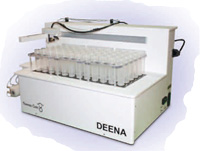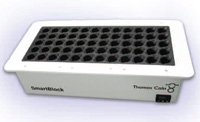AUTOMATED SAMPLE PREPARATION FROM THOMAS CAIN & SEAL
SEAL Analytical recently acquired Thomas Cain, designer and manufacturer of automated sample preparation equipment. This includes automated chemical addition, heating and mixing to reduce the need for manual handling and addition of hazardous chemicals and strong acids during the sample preparation and / or digestion process.
The DEENA gives the option for full automation from creation of standards to addition of reagents, mixing, digestion and reconstitution of sample volume. This increases safety and reproducibility in the  dispensing and mixing of hazardous chemicals and strong acids. The DEENA is fully controlled by a PC and the ASD (Automated Sample Digestion) software. The software is fully programmable and the processes are customizable based on your labs required methods. Many methods come pre-programmed for your convenience including common mercury and trace metals methods, which can be customized for your particular samples and digestions.
dispensing and mixing of hazardous chemicals and strong acids. The DEENA is fully controlled by a PC and the ASD (Automated Sample Digestion) software. The software is fully programmable and the processes are customizable based on your labs required methods. Many methods come pre-programmed for your convenience including common mercury and trace metals methods, which can be customized for your particular samples and digestions.
For labs that are looking to automate sample prep but do not require digestion or heating in their sample preparation, there is the ERICA. The ERICA gives all of the benefits of the DEENA but can be paired with Microwave digestion or other processes that simply require the automated preparation of standards and reliable addition of reagent to the samples and standards.
For labs that want to perform digestions but are not looking for  automation, there is the SMARTBLOCK. The SMARTBLOCK uses the same heating technology and corrosive resistant materials as the DEENA. It is a reliable and durable graphite block for mercury and metals digestions.
automation, there is the SMARTBLOCK. The SMARTBLOCK uses the same heating technology and corrosive resistant materials as the DEENA. It is a reliable and durable graphite block for mercury and metals digestions.
SEAL Analytical is excited to welcome Thomas Cain to the SEAL group. The addition of these systems will allow SEAL to further serve the water and soil analysis market.
Additional information on the Thomas Cain products can be found at www.thomascaininc.com and www.seal-analytical.com